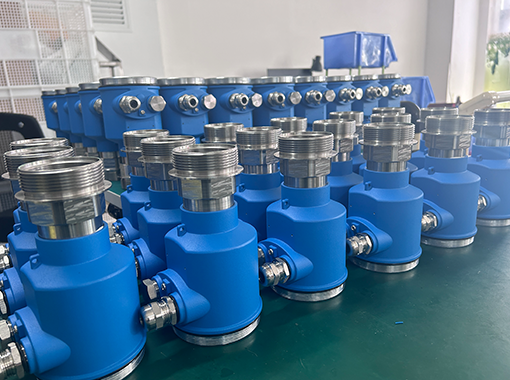With the booming development of the cement industry and the continuous improvement of the level of automation, the requirement to continuously monitor the material level of powder silos has become more and more urgent. Various powder silos in cement plants are an important part of the production process.
However, how to accurately and reliably measure the material level of the powder silo has always been a problem faced by cement plants. The main reason is that the powder silo will produce a large amount of dust when discharging materials, and the dust surface is very fluffy. When a non-contact ultrasonic material level sensor is used for measurement, signal attenuation is often caused, making it impossible to accurately and reliably measure the material level, especially during the feeding process. The instrument is often in a wave-loss state, but the instrument can still increase the material level value at the input rate, thus causing errors.
In fact, cement plants have always been one of the main applications of radar level transmitters. So how to make radar level sensor better used in cement plants?
The 80Ghz radar aluminum shell level sensor SK-R800NS developed by SKE adopts a non-contact measurement method with the medium. It is generally used in solid materials, process containers or situations where strong dust is prone to crystallization and condensation. Its beam angle is only 3.5°, and its energy is concentrated, which not only enhances the echo capability, but also helps avoid interference. It is an ideal choice for measuring solid powder and low dielectric constant media.
To make the radar level meter better used in all aspects of the cement plant, first of all, you need to choose the high frequency radar level meter with large range to meet the level detection requirements of various height silos in the cement plant. At the same time need to be able to penetrate the serious dust, even under the measurement conditions of clinker, ready-made cement and other media, but also to achieve -reliable, stable and accurate level. It also needs to have advanced echo processing technology, which can distinguish between true and false echo signals under a variety of harsh conditions to ensure the reliability of level measurement. If necessary, it is also necessary to use the elongated flare design, not only to facilitate the site installation requirements, but also to achieve a smaller microwave emission angle, thus improving the echo signal strength, to avoid interference within the launch range microwave radar level measurement signal.
Secondly, dust is a particularly significant feature in cement plants, and it is critical to address the impact of dust on the use of radar level meters. Although the microwave can penetrate the influence of dust, but in some extreme dust conditions, the raised dust will adhere to the radar wave transmitter electrodes, resulting in transmission signal attenuation or even complete loss. Sometimes the raised dust is so moist that it even forms mud on the flapper of the microwave radar level meter. In general, only by removing the dust and mud from the horn mouth can the normal use of the instrument be restored. To solve the above problem you can add dustproof device, add PTFE dust cover to the horn mouth to solve the problem, in addition, you can add the blowing system, if you meet the more humid dust, even if you use the dust cover, there will still be mud sticking on the dust cover. Regular replacement of dust cover will increase the workload of employees, then universal plus blowing device is the best choice.
One last thing to keep in mind is to avoid installing near inlets, bin walls, beams, etc. Use advanced echo processing software to remove fixed interference. However, if the interference echo is strong or the fixed interference position is in the center of the measurement range, the fixed interference echo suppression method may cause a large side effect measurement blind zone last time to report an error, due to the interference occurs in a relatively high position, the use of echo processing software technology to remove the interference. In short, to make the radar level meter in the cement plant for better application, the above aspects are should pay special attention to.
Application of high Frequency Radar Level Sensor in Cement Plant
Release date:2024年04月22日
Article author:SKE
Reading quantity:923
Related articles
-
The Irreplaceable Role of SKE 80G Radar Level Sensors in Wastewater Treatment Plants2025-02-26
-
How to Check Propane Tank Level by External-Mounted Gauge2023-04-27
-
Non-invasive Liquid Level Sensor of SKE is Used in the World's First Ultra-large Ethane Carrier2023-03-30
-
The "Integration Scheme of 80GHz Radar Level Gauge with Wireless Remote Transmission System " was Signed by SKE at the OTC Exhibition2023-05-09

 CN
CN


